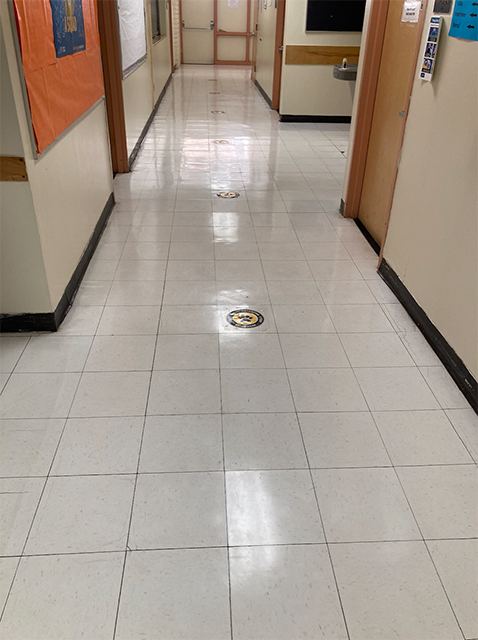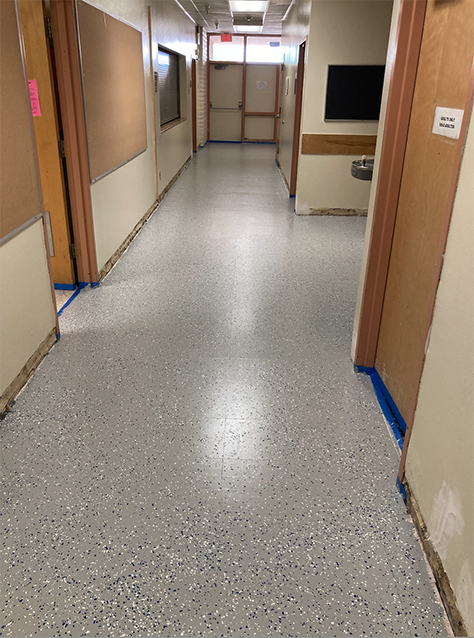Flooring Innovations Offer Eco-Friendly and Durable Options
Dave Darche
Many educational facility budgets remain tight and labor resources are limited, leaving school facilities managers feeling trapped into making do with old, dilapidated flooring. However, new innovations allow facilities the freedom to update old flooring, even on smaller budgets and in an eco-friendly manner.
Renewing an existing flooring surface—as opposed to tearing out and replacing with new material—is an innovative, growing option with many benefits including reduced environmental impact, shorter downtime, and the end result of a beautiful floor, even on a smaller budget.
Educational facilities require clean, durable, and slip-resistant flooring to accommodate the large numbers of students, staff, and other visitors passing through on a daily basis. Fortunately, eco-friendly and sustainable options allow facilities teams to say goodbye to the summer routine of polishing and resurfacing the floors.
Sustainability on a Budget is Achievable
Sustainability is a key driver in educational facility construction and maintenance. The flooring market offers a variety of options to refinish older flooring, and it’s important to carefully specify and source the right materials with sustainability, efficiency, and budget in mind.
The longer-term cost of flooring solutions—maintenance that includes closing large sections of the facility for long periods of time and paying maintenance teams overtime to work outside of operating hours—is often eliminated or at least greatly reduced with floor renewal systems. Floors are often renewed in hours instead of days or weeks, depending on the size of the area. Facilities managers save time on labor, and business operations can get back up and running quickly.
Flooring renewal creates a long-lasting surface, utilizes existing materials, keeps trash out of the landfill, and eliminates the carbon footprint and toxic fumes created by new products and materials. Many renewal system finishes are developed with 100% water-based, non-toxic chemistries, so indoor air quality remains safe for employees and visitors.
Additionally, the renewal process eliminates the need to ever polish the floor again. Considering today’s tight labor market, elimination of the polishing process can save significant workforce hours—not to mention reducing the use of toxic polishing products. Facilities managers can keep school events running on schedule by implementing a floor renewal and maintenance system that is eco-friendly and quick.
Renewal Preserves Environmental Resources and Valuable Time
A study by IVL Swedish Environmental Research Institute (IVL) revealed that renewing resilient floor surfaces can offer up to 92% reduction in carbon footprint and 95% savings in energy resources, versus replacing. Today, even the most worn, dilapidated resilient floors can be sustainably transformed. Consider these real-world examples:
Germany’s Phorms school in Berlin greatly needed an upgrade to a multifunctional space used by students, teachers, and parents. The flooring had been subjected to repeated stripping and polishing—two processes that resulted in a less-durable and dull floor. A new floor was not in the budget, but the renewal process presented a beautiful floor three days later, allowing sports, activities and assemblies to resume.
“There will be no future stripping and polishing, which of course saves costs and frees up time for our facilities staff,” said the school’s Administration Manager, Sandra Exner. “The ‘new floor’ is noticed by school colleagues, and the parents are also very happy with the upgrade.”
Sunnyside Unified School District in Arizona saved over $40,000 by having the floors renovated versus installing a full floor replacement. The district achieved an aesthetically-pleasing, cohesive design able to withstand heavy foot traffic from students and staff.

Sunnyside Unified School District Hallway Floor: Before
Photo Credit: Bona
The renewal process began with preparing the existing resilient flooring by stripping it, applying a floor repair solution where needed, abrading and cleaning the surface, and then applying a base color and color chips across the entire surface. Finally, a clear-coat sealant was applied. Upon that process completion, the floors will never need stripping again—a detail that’s easier on the indoor air quality and overall environment.

Sunnyside Unified School District Hallway Floor: After
“Another principal in our school district has seen pictures of this project and is anxiously waiting for the opportunity to have their floors upgraded,” said Manuel Portillo, maintenance custodian supervisor for Sunnyside.
Tips to Maintain Renewed Resilient Flooring
Identifying solutions that allow maintenance teams to efficiently and safely maintain resilient flooring should be top of mind for educational facilities. Since flooring tends to deteriorate from heavy foot traffic, spills, cleaning agents, scratches, and dents from equipment, among other factors, evaluating the cost of the total system throughout its lifetime—as well as the environmental impact of frequent stripping—are both important considerations.
Resilient flooring renewal is a sustainable and low-cost, high-results option to achieving safe, durable flooring surfaces. But the finished results must be properly maintained. Here are a few key maintenance tips:
- Develop and closely follow a maintenance plan.
- Train maintenance teams on how to properly care for the flooring surfaces.
- Clean high-traffic areas often, likely several times per week. Lower traffic areas need less-frequent cleaning (i.e. weekly).
- Map a “cleaning route” that keeps maintenance teams moving forward and avoids backtracking. This process increases efficiency and reduces the chances of spreading debris.
- A proper floor cleaning routine should include a combination of vacuuming, dry mopping and using PH neutral cleaners to remove dirt. Harsh cleaners are harmful to the indoor air quality and flooring finish.
- Don’t allow dirt to become ground into the floor, which will damage the finish.
- Utilize floor mats in high traffic areas to capture dirt. Clean or swap out the mats frequently so captured dirt won’t be tracked onto the flooring surface.
- Utilize furniture pads to prevent scratches and dents, and avoid sliding heavy pieces along the floor.
Refinishing is an eco-friendly, quick and simple solution, whether the goal is to update a space or completely transform it. Flooring renewal can be completed in a few days or a few hours (depending on the size of the area), drastically reducing downtime and allowing businesses to resume daily operations.
Dave Darche is the national market manager of adhesives/A&D for Bona US and has been in the flooring industry for more than 35 years. He currently serves on the National Wood Flooring Association Architect & Design Committee and is an NWFA Certified Inspector. He can be reached at [email protected].